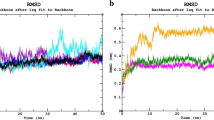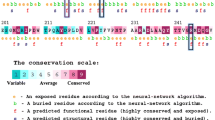Abstract
Lysosomal storage diseases comprise different forms of autosomal recessive disorders from which GM1 gangliosidosis has categorized by the accumulation of complex glycolipids associated with a range of progressive neurologic phenotypes. GM1 gangliosidosis is an inherited disorder that progressively destroys nerve cells (neurons) in the brain and spinal cord. GM1 has three main types of onsets, namely infantile (type I), juvenile (type II), and adult (type III) forms. This study provides a series of computational methods that examine the mutations that occurred in GLB1 protein. Initially, the mutational analysis started with 689 amino acid variants for a sequence-based screening and it was done with quite a few In-silico tools to narrow down the most significant variants by utilizing the standard tools; namely, Evolutionary analysis (77 variants), Pathogenicity prediction (44 variants), Stability predictions (30 variants), Biophysical functions (19 variants) and according to the binding site of protein structure with PDB ID 3THC, seven variants (Y83D, Y83H, Y270S, Y270D, W273R, W273D, and Y333H) were narrowed down. Structure based analysis was performed to understand the interacting profile of the native protein and variants with Miglustat; which is the currently used FDA drug as an alternative to enzyme replacement therapy. Molecular Docking study was done to analyze the protein interaction with Miglustat (ligand), as a result native (3THC) structure had a binding affinity of −8.18 kcal/mol and two variant structures had an average binding affinities of −2.61 kcal/mol (Y83D) and − 7.63 kcal/mol (Y270D). Finally, Molecular Dynamics Simulation was performed to know the mutational activity of the protein structures on Miglustat for 50,000 ps. The Y83D variant showed higher deviation than native protein and Y270D in all trajectory analysis. The analysis was done to the protein structures to check the structural variations happened through simulations. This study aids to understand the most deleterious mutants, the activity of the drug to the protein structure and also gives an insight on the stability of the drug with the native and selected variants.






Similar content being viewed by others
Data availability
All data generated or analyzed during this study are included in this published article (and its supplementary information files).
Abbreviations
- GLB1:
-
β-Galactosidase
- GM1 gangliosidosis:
-
Monosialotetrahexosylganglioside gangliosidosis-1
- MD:
-
Molecular Dynamics
- RMSD:
-
Root-Mean-Square Deviation
- RMSF:
-
Root-Mean-Square Fluctuation
- Rg:
-
Radius of Gyration
References
Abraham CS, Muthu S, Prasana JC, Armaković S, Armaković SJ, Rizwana B. F, Geoffrey B, David R. HA (2019) Computational evaluation of the reactivity and pharmaceutical potential of an organic amine: a DFT, molecular dynamics simulations and molecular docking approach. Spectrochim Acta - Part A Mol Biomol Spectrosc 222:117188. https://doi.org/10.1016/j.saa.2019.117188
Arash-Kaps L, Komlosi K, Seegräber M et al (2019) The clinical and molecular Spectrum of GM1 Gangliosidosis. J Pediatr 215:152–157.e3. https://doi.org/10.1016/j.jpeds.2019.08.016
Ashkenazy H, Abadi S, Martz E, Chay O, Mayrose I, Pupko T, Ben-Tal N (2016) ConSurf 2016: an improved methodology to estimate and visualize evolutionary conservation in macromolecules. Nucleic Acids Res 44:W344–W350. https://doi.org/10.1093/nar/gkw408
Bendl J, Stourac J, Salanda O, Pavelka A, Wieben ED, Zendulka J, Brezovsky J, Damborsky J (2014) PredictSNP: robust and accurate consensus classifier for prediction of disease-related mutations. PLoS Comput Biol 10:1–11. https://doi.org/10.1371/journal.pcbi.1003440
Bendl J, Musil M, Štourač J, Zendulka J, Damborský J, Brezovský J (2016) PredictSNP2: a unified platform for accurately evaluating SNP effects by exploiting the different characteristics of variants in distinct genomic regions. PLoS Comput Biol 12:1–18. https://doi.org/10.1371/journal.pcbi.1004962
Breiden B, Sandhoff K (2019) Lysosomal glycosphingolipid storage diseases. Annu Rev Biochem 88:461–485. https://doi.org/10.1146/annurev-biochem-013118-111518
Brunetti-Pierri N, Scaglia F (2008) GM1 gangliosidosis: review of clinical, molecular, and therapeutic aspects. Mol Genet Metab 94:391–396. https://doi.org/10.1016/j.ymgme.2008.04.012
Caciotti A, Garman SC, Rivera-Colón Y, Procopio E, Catarzi S, Ferri L, Guido C, Martelli P, Parini R, Antuzzi D, Battini R, Sibilio M, Simonati A, Fontana E, Salviati A, Akinci G, Cereda C, Dionisi-Vici C, Deodato F, d'Amico A, d'Azzo A, Bertini E, Filocamo M, Scarpa M, di Rocco M, Tifft CJ, Ciani F, Gasperini S, Pasquini E, Guerrini R, Donati MA, Morrone A (2011) GM1 gangliosidosis and Morquio B disease: an update on genetic alterations and clinical findings. Biochim Biophys Acta Mol basis Dis 1812:782–790. https://doi.org/10.1016/j.bbadis.2011.03.018
Capriotti E, Fariselli P, Calabrese R, Casadio R (2005) Predicting protein stability changes from sequences using support vector machines. Bioinformatics 21:54–58. https://doi.org/10.1093/bioinformatics/bti1109
Chen CW, Lin J, Chu YW (2013) iStable: off-the-shelf predictor integration for predicting protein stability changes. BMC Bioinformatics 14. https://doi.org/10.1186/1471-2105-14-S2-S5
Dassault Systèmes BIOVIA (2016) Discovery studio 2016. Dassault Systèmes, San Diego
Essmann U, Geiger A (1995) Molecular dynamics simulation of vapor deposited amorphous ice. J Chem Phys 103:4678–4692. https://doi.org/10.1063/1.470655
Forli S, Huey R, Pique ME et al (2016) Computational protein–ligand docking and virtual drug screening with the AutoDock suite. Nat Protoc 11:905–919. https://doi.org/10.1002/jcc.21256
Georgiou T, Stylianidou G, Anastasiadou V, Caciotti A, Campos Y, Zammarchi E, Morrone A, D'azzo A, Drousiotou A (2005) The Arg482His mutation in the β-galactosidase gene is responsible for a high frequency of GM1 gangliosidosis carriers in a Cypriot village. Genet Test 9:126–132. https://doi.org/10.1089/gte.2005.9.126
Glaser F, Pupko T, Paz I, Bell RE, Bechor-Shental D, Martz E, Ben-Tal N (2003) ConSurf: identification of functional regions in proteins by surface-mapping of phylogenetic information. Bioinformatics 19:163–164. https://doi.org/10.1093/bioinformatics/19.1.163
Hayward C, Patel HC, Manohar SG, Lyon AR (2015) Gene therapy for GM1 gangliosidosis: challenges of translational medicine. Ann Transl Med 3:2–5. https://doi.org/10.3978/j.issn.2305-5839.2015.02.28
Hess P, Dougherty GJ (1997) Gene therapy monitoring: clinical monitoring for efficacy and potential toxicity. Mol Diagn 2:147–155. https://doi.org/10.1016/S1084-8592(97)80021-5
Hofer D, Paul K, Fantur K, Beck M, Bürger F, Caillaud C, Fumic K, Ledvinova J, Lugowska A, Michelakakis H, Radeva B, Ramaswami U, Plecko B, Paschke E (2009) GM1 gangliosidosis and Morquio B disease: expression analysis of missense mutations affecting the catalytic site of acid β-galactosidase. Hum Mutat 30:1214–1221. https://doi.org/10.1002/humu.21031
Karimzadeh P, Naderi S, Modarresi F, Dastsooz H, Nemati H, Farokhashtiani T, Shamsian BS, Inaloo S, Faghihi MA (2017) Case reports of juvenile GM1 gangliosidosisis type II caused by mutation in GLB1 gene. BMC Med Genet 18:1–7. https://doi.org/10.1186/s12881-017-0417-4
Leonard A, Lebecque P, Dingemanse J, Leal T (2012) A randomized placebo-controlled trial of miglustat in cystic fibrosis based on nasal potential difference. J Cyst Fibros 11:231–236. https://doi.org/10.1016/j.jcf.2011.12.004
Miyamoto S, Kollman PA (1992) Molecular dynamics studies of calixspherand complexes with alkali metal cations: calculation of the absolute and relative free energies of binding of cations to a calixspherand. J Am Chem Soc 114:3668–3674. https://doi.org/10.1021/ja00036a015
Ohto U, Usui K, Ochi T, Yuki K, Satow Y, Shimizu T (2012) Crystal structure of human β-galactosidase: structural basis of G M1 gangliosidosis and morquio B diseases. J Biol Chem 287:1801–1812. https://doi.org/10.1074/jbc.M111.293795
Okada S, O’Brien JS (1968) Generalized gangliosidosis: Beta-galactosidase deficiency. Science (80- ) 160:1002–1004. https://doi.org/10.1126/science.160.3831.1002
Ou L, Przybilla MJ, Whitley CB (2017) Phenotype prediction for mucopolysaccharidosis type i by in silico analysis. Orphanet J Rare Dis 12:1–14. https://doi.org/10.1186/s13023-017-0678-1
Ou L, Przybilla MJ, Whitley CB (2018) SAAMP 2.0: an algorithm to predict genotype-phenotype correlation of lysosomal storage diseases. Clin Genet 93:1008–1014. https://doi.org/10.1111/cge.13226
Ou L, Kim S, Whitley CB, Jarnes-Utz JR (2019) Genotype-phenotype correlation of gangliosidosis mutations using in silico tools and homology modeling. Mol Genet Metab Reports 20:100495. https://doi.org/10.1016/j.ymgmr.2019.100495
Parrinello M, Rahman A (1981) Polymorphic transitions in single crystals: a new molecular dynamics method. J Appl Phys 52:7182–7190. https://doi.org/10.1063/1.328693
Paschke E, Milos I, Kreimer-Erlacher H, Hoefler G, Beck M, Hoeltzenbein M, Kleijer W, Levade T, Michelakakis H, B. R (2001) Mutation analyses in 17 patients with a deficiency in acid β-galactosidase: three novel point mutations and high correlation of mutation W273L with Morquio disease type B. Hum Genet 109:159–166. https://doi.org/10.1007/s004390100570
Posse de Chaves E, Sipione S (2010) Sphingolipids and gangliosides of the nervous system in membrane function and dysfunction. FEBS Lett 584:1748–1759. https://doi.org/10.1016/j.febslet.2009.12.010
Rigat BA, Tropak MB, Buttner J, Crushell E, Benedict D, Callahan JW, Martin DR, Mahuran DJ (2012) Evaluation of N-nonyl-deoxygalactonojirimycin as a pharmacological chaperone for human GM1 gangliosidosis leads to the identification of a feline model suitable for testing enzyme enhancement therapy. Mol Genet Metab 107:203–212. https://doi.org/10.1016/j.ymgme.2012.06.007
Schüttelkopf AW (2004) PRODRG: a tool for high-throughput crystallography of protein-ligand complexes. 10:1214–1221. https://doi.org/10.1002/humu.21031
Schwede T, Kopp J, Guex N, Peitsch MC (2003) SWISS-MODEL: an automated protein homology-modeling server. Nucleic Acids Res 31:3381–3385. https://doi.org/10.1093/nar/gkg520
Sneha P, Kumar Thirumal D, Tanwar H et al (2017) Structural analysis of G1691S variant in the human Filamin B gene responsible for Larsen syndrome: a comparative computational approach. J Cell Biochem 118:1900–1910. https://doi.org/10.1002/jcb.25920
Tanwar H, Kumar DT, Doss CGP, Zayed H (2019) Bioinformatics classification of mutations in patients with Mucopolysaccharidosis IIIA. Metab Brain Dis 34(6):1577–1594
Tavtigian SV, Deffenbaugh AM, Yin L, Judkins T, Scholl T, Samollow PB, de Silva D, Zharkikh A, Thomas A (2006) Comprehensive statistical study of 452 BRCA1 missense substitutions with classification of eight recurrent substitutions as neutral. J Med Genet 43:295–305. https://doi.org/10.1136/jmg.2005.033878
Thirumal Kumar D, Eldous HG, Mahgoub ZA, George Priya Doss C, Zayed H (2018) Computational modelling approaches as a potential platform to understand the molecular genetics association between Parkinson’s and Gaucher diseases. Metab Brain Dis 33:1835–1847. https://doi.org/10.1007/s11011-018-0286-3
Thirumal Kumar D, Jain N, Udhaya Kumar S et al (2020) Identification of potential inhibitors against pathogenic missense mutations of PMM2 using a structure-based virtual screening approach. J Biomol Struct Dyn. https://doi.org/10.1080/07391102.2019.1708797
Wagner J, Damaschke N, Yang B, Truong M, Guenther C, McCormick J, Huang W, Jarrard D (2015) Overexpression of the novel senescence marker β-galactosidase (GLB1) in prostate cancer predicts reduced PSA recurrence. PLoS One 10:1–15. https://doi.org/10.1371/journal.pone.0124366
Weismann CM, Ferreira J, Keeler AM, Su Q, Qui L, Shaffer SA, Xu Z, Gao G, Sena-Esteves M (2015) Systemic AAV9 gene transfer in adult GM1 gangliosidosis mice reduces lysosomal storage in CNS and extends lifespan. Hum Mol Genet 24:4353–4364. https://doi.org/10.1093/hmg/ddv168
Yang CF, Wu JY, Tsai FJ (2010) Three novel beta-galactosidase gene mutations in Han Chinese patients with GM1 gangliosidosis are correlated with disease severity. J Biomed Sci 17:1–8. https://doi.org/10.1186/1423-0127-17-79
Yuan S, Chan HCS, Hu Z (2017) Using PyMOL as a platform for computational drug design. Wiley Interdiscip Rev Comput Mol Sci 7:1–10. https://doi.org/10.1002/wcms.1298
Acknowledgments
The authors like to acknowledge Sri Ramachandra Institute of Higher Education and Research (DU) for their constant support.
Author contribution statement
The authors PK and MP were involved in work design and in drafting the manuscript. PK was involved in data collection and mutational analysis. MP carried out the docking and dynamics related to the study. RM was involved in making the study design, supervising the work and critically examined the manuscript for submission. The authors approve the manuscript at its correct form.
Author information
Authors and Affiliations
Corresponding author
Ethics declarations
This article does not contain any studies with human or animal subjects performed by the any of the authors.
Conflict of interest
The authors declare that there are no conflicts of interest.
Additional information
Publisher’s note
Springer Nature remains neutral with regard to jurisdictional claims in published maps and institutional affiliations.
Supplementary Information
ESM 1
(DOCX 55 kb)
Rights and permissions
About this article
Cite this article
Priyanka, K., Madhana Priya, N. & Magesh, R. A computational approach to analyse the amino acid variants of GLB1 protein causing GM1 Gangliosidosis. Metab Brain Dis 36, 499–508 (2021). https://doi.org/10.1007/s11011-020-00650-y
Received:
Accepted:
Published:
Issue Date:
DOI: https://doi.org/10.1007/s11011-020-00650-y




